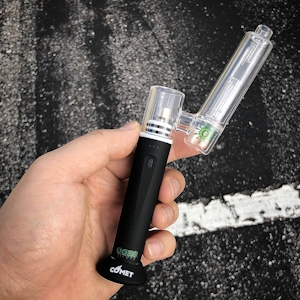
Woman Vaping behind the wheel
Are Weed Pens Safe? What You Should Know
Are weed pens dangerous? Are weed pens good? Let's explore.
These days, it seems like weed pens have made a true name for themselves.
With their sleek, discreet, and oh-so-convenient style, these pens can give a quick hit of calm without any telltale signs that you’ve smoked weed.
But are weed pens bad for you? Is there such thing as the safest weed pen to use?
Let’s explore.
Are Weed Pens Safe

When considering the safety of weed pens, several factors come into play.
Weed Vape Coils: Aluminum Vs. Ceramic
Common materials for the heating elements in these devices include aluminum, ceramic, and glass, each with its own set of implications for user safety.
Ceramic coils: These are often preferred in the vaping community because they don’t leach chemicals into the vapor and are known for providing pure flavor. However, if the ceramic is low quality or improperly made, it can potentially release silica particles into the lungs, although this is a rare occurrence when dealing with reputable brands.
Aluminum Coils: These have good heat conductivity, helping pens heat up quickly and maintain consistent temperatures. The safety concern with aluminum arises from the potential exposure to metals if the aluminum degrades, although this is also primarily a concern with lower-quality models.
Alternatively, glass heating elements are also used and similar to ceramic in that they provide a pure taste and reduce the likelihood of unwanted chemical reactions. But, they’re way less common to come across because they’re quite fragile and don’t make practical sense to use compared to the other materials.
Quality Of Vaping Product Matters In Safe Weed Pens
Beyond the type of material, the safety of weed pens also largely depends on the quality of the vape juice itself.
Some products may contain harmful additives or thinning agents like propylene glycol (PG) and polyethylene glycol (PEG), which can degrade into formaldehyde and other carcinogens at high temperatures. Opting for products that are transparent about their ingredients and avoiding those containing harmful chemicals is crucial.
Vaping At High Temperatures Can Be Dangerous
Some vapes come equipped with temperature control. Some of these temperatures can reach as high as 446°F (230°C). The extreme heat is used to maximize the extraction of cannabinoids like THC, but vaping at this kind of temperatures can actually lead to the degradation of flavor and may release harmful chemicals into your vapor.
The ideal temperature for vaping is a moderate range of 350-400°F (177-204°C).
What To Look For When Buying The Safest Weed Pens
When you’re in the market for a weed vape pen, there are several key factors to consider ensuring you’re purchasing a safe and reliable product. First, consider the materials used in the heating element and air path. The best options are ceramic or glass due to their heat resistance and inert properties, reducing the chance of toxins getting into the vapor. Avoid devices with plastic or cheap metal parts.
Next, consider heat control. Vape pens with adjustable temperature control are ideal because they allow you to manage the heat, preventing cannabinoids from burning and producing a harsh, potentially harmful smoke.
Third, consider the brand. Purchase vape pens from established, reputable brands with good reviews. These companies are more likely to prioritize the safety and well-being of their customers and less likely to skimp on materials.
Battery life is also an important consideration. A vape pen with a longer battery life will provide a better vaping experience, as you won’t constantly need to recharge it. Moreover, extended battery life often signifies better overall product quality.
Finally, pay attention to how the device feels in your hand. A well-constructed, sturdy vape pen will not only last longer but also offer a more enjoyable user experience.
What Is Off-Gassing?

Off-gassing, in the context of vaping, refers to the release of vapor from unwanted materials that can produce toxins or harmful chemicals. This can happen for a few different reasons. When you first get your vape, residual oils or factory residue may still be present in the device. Heating up your vaporizer without anything in the material chamber (a process known as an initial burn off) can help burn away or off-gas these materials.
It’s also wise to do a burn off cycle after each cleaning to remove any leftover cleaning solution. The last thing you want is to inhale remnants of cleaning chemicals along with your vapor. Off-gassing during a burn off cycle is normal and to be expected.
What’s more nefarious is when your vape is off gassing during regular use due to sub-par materials. Manufacturers who skimp on the materials around the heating element or air path risk releasing toxins along with your herb vapor, negating any potential benefits of vaping and possibly causing more harm than traditional smoking.
So, Are Weed Pens Bad
When it comes to convenience and discretion, weed pens rock.
But, regarding safety, weed pens might not get the gold medal. They may be safer than smoking, but long-term studies are still needed to understand the depth behind weed vape safety.
Herb Recommended Products:
READ MORE










